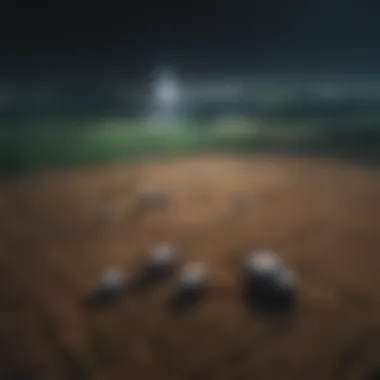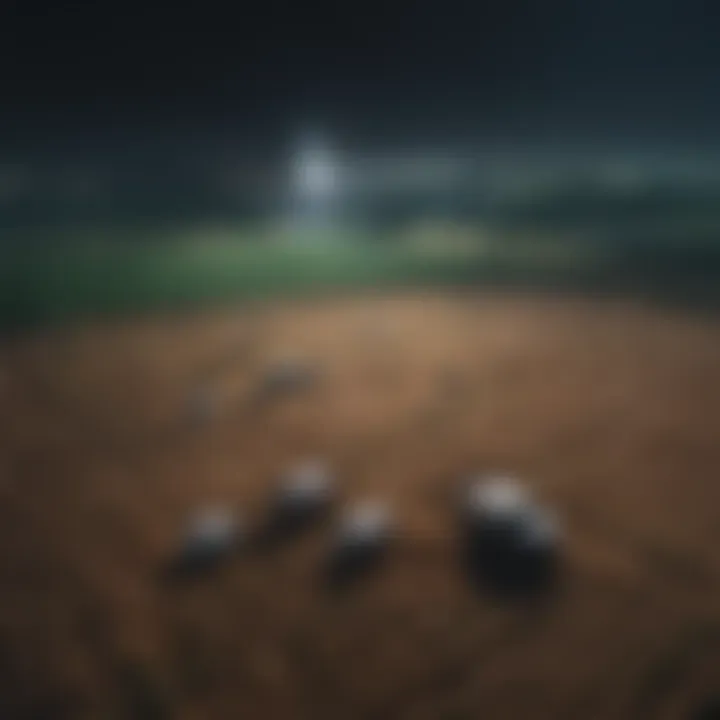Exploring the Capabilities of Rapideye Satellites


Intro
The development of satellite technology has reshaped our ability to understand and interact with the planet. Rapideye satellites standout as an important tool in this realm. These satellites provide high-resolution images and valuable data used across different sectors. They are particularly useful in agriculture, environmental monitoring, and disaster management. The significance of satellite imagery cannot be overstated, and this article will outline the main capabilities and applications of Rapideye satellites.
Key Findings
Major Results
Rapideye satellites offer several key advantages that set them apart from other Earth observation systems. One of the most notable capabilities is their ability to capture high-resolution imagery taken in different spectral bands. These bands include red, green, blue, and near-infrared, which allow for detailed analysis of surface conditions.
A standout result from studies utilizing Rapideye satellites is their efficiency in monitoring agricultural practices. They provide insights into crop health and growth patterns, helping farmers optimize yields while managing resources effectively.
Additionally, the data collected by these satellites has been instrumental in environmental assessments. For example, they have been used to monitor deforestation and track changes in land use over time. This reveals critical information about ecosystem health and informs conservation efforts.
Discussion of Findings
The implications of using Rapideye satellite data extend to policy-making and scientific research. By providing accurate and timely information, these satellites assist authorities in forming strategies that address climate change, reduce risks from natural disasters, and implement sustainable agriculture practices. The gathered data is not just informative; it influences decisions that can have widespread social and economic impacts.
"Satellites like Rapideye illuminate the complexities of our planet's systems, offering crucial data for informed decision-making."
Methodology
Research Design
The research incorporated a mixed-methods approach. By combining quantitative data from satellite imagery with qualitative analysis from user feedback, a well-rounded perspective on the applications of Rapideye satellites was achieved. This approach allows for a better understanding of practical applications while confirming the accuracy of satellite data.
Data Collection Methods
Data collection was primarily centered on satellite imaging, supported by ancillary statistics and reports from various agencies involved in Earth observation. The research also sought insights from practitioners and researchers who have utilized Rapideye data, enhancing the depth of information and ensuring relevance to current practices in multiple fields.
Foreword to Rapideye Satellites
Rapideye satellites represent a significant advancement in Earth observation technology. Understanding their capabilities and applications is crucial for various fields such as agriculture, environmental science, and urban planning. With their ability to monitor real-time changes on the Earth's surface, these satellites provide invaluable data that inform decisions across multiple industries.
Understanding Satellite Technology
Satellite technology encompasses a broad range of systems designed to collect and transmit data from space. Rapideye satellites are specifically equipped with multiple sensors that capture high-resolution imagery of the Earth. This technology enables users to analyze land usage, vegetation health, and urban expansion with greater accuracy. The use of satellite technology has become increasingly important in today’s data-driven world. Enhanced imagery allows for extensive analysis of geographical changes, benefiting researchers, governmental organizations, and private entities alike.
Key features of satellite technology include:
- Sensor types: Various sensors can capture different kinds of data, including panchromatic and multispectral images.
- Resolution levels: High-resolution imagery provides detailed views, making it easier to assess changes in landscapes.
- Data transmission: Satellites transmit gathered data to ground stations for processing, ensuring timely and effective communication.
The interrelationship between technology and the applications of Rapideye satellites underscores their importance in addressing contemporary challenges like climate change and resource management.
Historical Context of Rapideye Development
The development of Rapideye satellites is rooted in the increasing demand for high-quality Earth observation data. Since the dawn of satellite technology, researchers and policymakers have recognized the need for reliable data to monitor environmental changes. Rapideye was initiated in the early 2000s and launched its first satellite in 2008. This timeline reflects a consistent effort to enhance satellite capabilities, particularly in remote sensing.
The historical context of Rapideye satellites includes crucial milestones:
- Initial conception: The project was developed to address gaps in data acquisition, especially for precision agriculture and environmental monitoring.
- Launch and operation: The five satellites in the Rapideye constellation provide continuous coverage and redundancy, ensuring no data is lost during operations.
- Technological advancements: Over the years, advancements in sensor technology and data processing methods have significantly increased the usability and accuracy of the information extracted from these satellites.
Understanding the origins and evolution of Rapideye satellites helps to appreciate their current capabilities and context in the broader framework of satellite technology.
Technical Specifications of Rapideye Satellites
Understanding the technical specifications of Rapideye satellites is crucial to appreciate their capabilities fully. These specifications not only define the functionality of satellite systems but also highlight their significance in various applications. Various components work together to enable these satellites to capture high-quality imagery and provide valuable data for analysis. The balance between design, instrumentation, and operational parameters enables the effective use of the satellites in fields like agriculture and environmental monitoring.


Satellite Design and Structure
The design and structure of Rapideye satellites are pivotal in establishing their reliability and performance. Each satellite measures approximately 60 cm in diameter and has a modular structure, allowing for efficient integration of different components. This compact size promotes favorable launch dynamics and minimizes costs. Constructed with lightweight materials, these satellites can remain in orbit without excessive energy expenditure.
The structure protects sensitive instruments from space conditions, ensuring longevity and operational integrity.
Instrumentation and Sensing Equipment
Instrumentation involves various advanced sensing capabilities that contribute to the overall effectiveness of Rapideye satellites. Equipped with multispectral optical sensors, these satellites capture data across five distinct wavelengths. This broad spectrum allows for sophisticated environmental analysis, helping users differentiate between various land covers and assess agricultural health. The sensors provide information about vegetation indices, soil moisture levels, and crop conditions.
The data gathered can be processed to develop insightful visualizations, enabling stakeholders to make informed decisions.
Orbit Characteristics and Coverage
Rapideye satellites operate at an altitude of roughly 630 kilometers, which provides a balance between high-resolution imagery and extensive coverage. This altitude allows the satellites to capture detailed ground images while covering a large area during each pass. The polar orbit ensures that the satellites can revisit the same location frequently, which is advantageous for monitoring changes over time. The capability to cover about 650 kilometers width at once ensures comprehensive data collection across diverse geographic regions.
Furthermore, this orbital configuration supports applications spanning agriculture, urban planning, and disaster response, enhancing their utility across various sectors.
The integration of technical specifications in Rapideye satellites allows for effective and Acontinuous monitoring of environmental changes, supporting crucial decision-making processes in different fields.
Operational Capabilities
The operational capabilities of Rapideye satellites are pivotal to their mission as tools for Earth observation. Understanding these capabilities offers insight into how these satellites gather, process, and deliver high-quality data that serves multiple sectors. The specific elements of operational capabilities include imagery resolution, data acquisition efficiency, processing speed, and the satellite's overall responsiveness.
Imagery Resolution and Quality
One of the defining features of Rapideye satellites is their imagery resolution and quality. These satellites are equipped with five identical sensors, each capturing images in multiple spectral bands. The spatial resolution of their imagery is 5 meters. This level of detail allows for precise monitoring of land use, vegetation health, and urban development.
The quality of the images produced is critical for users in various fields. For instance, in agriculture, farmers need detailed imagery to assess crop conditions and health. In urban planning, high-quality images assist in tracking infrastructure changes over time. The combination of high spatial resolution and multiple spectral channels allows Rapideye satellites to distinguish between different land covers and to perform analyses that are crucial for both research and practical applications.
This capability ensures that users can generate actionable insights from the data, leading to informed decision-making. The rich data sets produced have applications in monitoring seasonal changes, understanding ecological dynamics, and assessing environmental impacts.
Data Acquisition and Processing
Data acquisition and processing constitute the backbone of the operational efficiency of Rapideye satellites. An important aspect is the frequency with which these satellites can capture images. Rapideye satellites can revisit the same location on Earth within a relatively short period, typically every five days, depending on the requested coverage. This capability allows for time-series analysis, which is essential for observing changes over time in various contexts, such as land use changes or disaster response scenarios.
Once the data is acquired, it undergoes a series of processing steps to ensure usability. This includes geo-referencing and radiometric correction, which enhance accuracy and ensure that the data corresponds to the Earth’s actual locations and conditions. The satellite's onboard systems are designed to process this vast amount of data efficiently, balancing the need for speed with the requirements for quality.
Furthermore, the processing can often be customized depending on the end-user requirements. For example, specific processing algorithms may enhance certain spectral bands, suited for environmental monitoring or agricultural assessments. The adaptability in processing ensures that the acquired data meets the distinct needs of various industries.
"The operational capabilities of Rapideye satellites are instrumental in enabling effective data-driven decisions across several fields."
In summary, the operational capabilities of Rapideye satellites enrich the value of satellite imagery, making it a vital resource for professionals engaged in agricultural management, environmental monitoring, urban planning, and crisis management. The focus on imagery resolution and efficient data acquisition and processing ensures they remain at the forefront of satellite technology.
Applications of Rapideye Satellites
The applications of Rapideye satellites are varied and profound. They play a crucial role in addressing challenges across multiple sectors, reflecting the growing reliance on satellite data for monitoring and analysis. This section elaborates on how these satellites contribute to different domains, specifically their benefits, considerations, and implications.
Agricultural Monitoring and Management
Rapideye satellites are invaluable to agriculture. Their multispectral imaging capabilities allow for precision farming techniques. Farmers can monitor crop health, assess soil conditions, and optimize resource allocation. By providing detailed imagery at regular intervals, these satellites enable farmers to identify areas requiring attention.
Key benefits include:
- Enhanced yield prediction: Data derived from the satellites helps in forecasting yields based on real-time health assessments.
- Pest and disease detection: Early identification of issues can lead to timely interventions, reducing overall crop loss.
- Water management: Efficient use of water resources is essential, especially in drought-prone areas. Satellite data aids in understanding water needs.
Overall, the integration of Rapideye satellite technology contributes to sustainable agricultural practices.
Environmental Surveillance


Environmental surveillance is another major application. These satellites monitor land cover changes, deforestation rates, and biodiversity patterns. This information is critical for conservation efforts and environmental policy-making.
Some important uses include:
- Habitat mapping: Identifying and protecting habitats supports conservation initiatives.
- Pollution tracking: Monitoring environmental pollution levels helps in assessing the impact on ecosystems.
- Climate studies: Long-term data from these satellites aids researchers in understanding climate variations over time.
Through continuous monitoring, Rapideye satellites provide essential data for environmental management.
Urban Planning and Development
In urban scenarios, Rapideye satellites informing planners and developers. They offer rich insights into land use patterns, support infrastructural development, and assist in urban renewal projects.
Key aspects include:
- Spatial analysis: Understanding urban sprawl through spatial data supports sustainable planning.
- Land use optimization: Effective land use planning is critical for growth and development.
- Infrastructure monitoring: Regular satellite imagery allows for monitoring the state of infrastructure over time.
The information derived from Rapideye satellites reinforces informed decision-making for urban infrastructure development.
Disaster Management and Response
Lastly, the role of Rapideye satellites in disaster management cannot be overstated. They facilitate rapid assessments during emergencies, providing critical data for crisis response teams. This application is essential for effective disaster mitigation.
Important functions include:
- Pre-disaster risk assessment: Satellites offer insights into vulnerable areas, helping prepare for potential hazards.
- Real-time tracking: During disasters, updated satellite imagery assists with tracking and monitoring changes, such as flooding or wildfire spread.
- Post-disaster recovery support: Analyzing damage caused by natural disasters helps in planning recovery efforts.
In summary, Rapideye satellites enhance disaster response, making the data they provide vital for improving resilience and recovery efforts.
Data Interpreting and Analysis
Data interpreting and analysis is vital in understanding the full extent of Rapideye satellite capabilities. The data gathered by these satellites provide key insights into various phenomena on Earth. With advanced technology, users can make sense of large sets of spatial data, turning raw information into actionable intelligence. This process affects numerous fields, including agriculture, environmental science, and urban planning.
Methods for Remote Sensing Analysis
Remote sensing analysis involves several techniques to convert satellite data into useful information. These methods can be categorized broadly into spectral analysis, statistical classification, and change detection.
- Spectral Analysis: This approach involves examining different wavelengths of light reflected from surfaces. By comparing these wavelengths, one can determine the material properties of objects on the ground. This is crucial for identifying vegetation types or assessing water quality.
- Statistical Classification: This method uses algorithms to categorize satellite imagery based on patterns. Common algorithms include maximum likelihood classification and support vector machines. These techniques allow for efficient mapping of land use or land cover.
- Change Detection: This technique involves comparing satellite images taken at different times to identify changes on the Earth's surface. Change detection is essential for monitoring deforestation, urban expansion, and natural disasters.
Each of these methods plays a significant role in translating complex data into comprehensible formats, thus enabling informed decision-making.
Integration with Geographic Information Systems
Integrating satellite data with Geographic Information Systems (GIS) enhances the ability to visualize, analyze, and interpret spatial information. GIS provides tools for storing vast amounts of data and performing complex analyses.
- Spatial Analysis: GIS allows for various spatial analyses, from simple overlays to complex modeling tasks. Users can assess relationships between different geographic features, such as proximity to water sources or population density.
- Visualization: The combination of Rapideye satellite data with GIS tools offers powerful visualization techniques. Heat maps, 3D models, and interactive dashboards present data in ways that highlight trends and anomalies.
- Data Management: GIS can handle large datasets, computer system resources become more efficient. Satellite imagery is time-sensitive, and combining this with GIS ensures timely analysis and response, especially in sectors like disaster management.
The consideration of how satellite data integrates into GIS is crucial. This integration enables a multidisciplinary approach to problem-solving, enhancing both accuracy and relevance in applications.
Implications for Scientific Research
Scientific research relies heavily on accurate data, and the Rapideye satellites provide crucial insights in various domains. The implementation of this technology impacts climate science, environmental conservation, and resource management significantly. Not only do these satellites deliver high-resolution images of Earth, but they also furnish a large volume of data critical for analysis.
Through their capabilities, Rapideye satellites allow researchers to monitor changing environmental conditions in real-time. This information aids in various studies, ranging from urban expansion to agricultural viability. Their role in examining Earth’s ecosystems cannot be overstated. Specific aspects of these implications are detailed below.
Contributions to Climate Change Studies
Rapideye satellites significantly contribute to understanding climate change by offering precise data on land usage and vegetation cover. This data is essential in tracking the effects of global warming on various ecosystems. Here are some aspects of their contribution:


- Vegetation Monitoring: The satellites monitor changes in vegetation cover over time, providing insights on deforestation rates and forest replenishment. Understanding these trends helps in assessing carbon sequestration capabilities of forests.
- Land Use Changes: By analyzing agricultural practices, urban development, and other land-use patterns, researchers can gauge how human activities contribute to climate change.
- Data Integration: Rapideye satellite data can be integrated with other datasets, such as meteorological data, to model climate scenarios. This synergy enhances the accuracy of predictions and strategies for mitigation.
"The information derived from Rapideye satellites offers a clear view of Earth's conditions, thus supporting effective policy-making and climate strategies."
Role in Biodiversity Conservation
The application of Rapideye technology extends to biodiversity conservation. These satellites help in monitoring habitats, understanding species distribution, and managing protected areas. Key contributions include:
- Habitat Mapping: High-resolution imagery can identify critical habitats, enabling conservationists to focus efforts on areas most in need of protection.
- Species Tracking: The ability to observe changes in land cover allows scientists to track shifts in species populations and distributions, essential for informing conservation efforts.
- Impact Assessment: Evaluating the impact of environmental policies relies on accurate data. Using Rapideye satellites, researchers can assess the effectiveness of conservation strategies over time.
Dependence on Satellite Data
Satellite data has become a cornerstone in multiple fields ranging from agriculture to urban planning. Dependence on this data has grown significantly due to the increasing need for accurate and timely information. Rapideye satellites exemplify this trend. Their advanced capabilities facilitate an array of applications that rely heavily on reliable satellite data for informed decision-making.
The benefits of utilizing satellite data include unprecedented access to real-time information and the ability to cover vast areas quickly. This leads to improved monitoring of environmental changes, agricultural conditions, and urban development. However, while the reliance on this data offers many advantages, certain considerations must be addressed to ensure its effective application.
Data Reliability and Accuracy
The reliability and accuracy of satellite data are of utmost importance. Rapideye satellites provide high-resolution imagery that is essential for various applications. This imagery supports precision agriculture and environmental monitoring effectively. However, it is critical to understand that the accuracy of the data can be influenced by several factors.
- Sensor Calibration: Regular calibration of onboard sensors is necessary. Slight deviations can lead to significant errors in data interpretation.
- Atmospheric Conditions: Weather impacts the quality of the images captured. Clouds, fog, or haze can obscure the view and result in incomplete datasets.
- Geometric Distortion: The position of a satellite in orbit can lead to distortions in the data. Accurate modeling is required to minimize these effects.
Ensuring high standards in data collection and processing will lead to more reliable and actionable insights.
Challenges in Satellite Operations
Operating satellites like Rapideye presents several challenges.
- Technical Failures: Satellites are complex machines. Technical issues can arise, which may temporarily impair their functionality.
- Orbital Decay: Over time, satellites may experience orbital decay. This affects their coverage and necessitates advancements in satellite technology to mitigate the effects.
- Data Management: Handling the vast amounts of data generated is another challenge. Efficient processing and storage solutions must be in place to make the information accessible for users.
- Security Concerns: There are potential security risks associated with satellite data. Protecting sensitive information from misuse is essential in maintaining the integrity of the data collected.
As reliance on satellite data continues, addressing these challenges will be vital for enhancing the effectiveness of services that depend on such data.
Future Prospects of Rapideye Technology
The landscape of remote sensing is evolving rapidly, and the role of Rapideye satellites is at the forefront of this change. Understanding the future prospects of Rapideye technology is crucial for multiple fields such as agriculture, environmental monitoring, and urban planning. By enhancing capabilities and establishing new applications, Rapideye satellites can continue to provide critical data.
Advancements in Satellite Sensors
Advancements in satellite sensors are pivotal for improving the performance and functionality of Rapideye satellites.
- Higher Resolution Imaging: Future sensor technology aims to provide higher resolution imagery. This enhancement will allow for more detailed observations, which can significantly benefit precision agriculture and natural resource management.
- Multi-Spectral and Hyperspectral Sensing: New sensor technologies are pushing towards multi-spectral and hyperspectral imaging. These advancements enable the capture of a broader spectrum of wavelengths, allowing for better analysis of vegetation health and soil properties.
- Real-Time Data Transmission: Improvements in data transmission technology can facilitate near real-time data access. This is critical for applications in disaster response where rapid decision-making is essential.
The integration of these advancements will make Rapideye satellites more reliable and versatile, leading to greater utility across various disciplines.
Potential for Increased Applications
The potential for increased applications of Rapideye satellites is significant, driven by technological advancements and growing data needs.
- Climate Adaptation Strategies: With climate change becoming a pressing concern, these satellites can offer valuable data for formulating effective climate adaptation strategies. This includes monitoring changes in land use and land cover, which are essential for environmental management.
- Enhanced Disaster Monitoring: The growing frequency of natural disasters calls for improved monitoring. Rapideye satellites could provide data to predict and track disasters more effectively, thereby enhancing emergency preparedness.
- Urbanization Tracking: As urban areas expand rapidly, these satellites can help in monitoring urbanization patterns. This information can be crucial for sustainable urban planning and infrastructure development.
"The future of Rapideye technology holds great promise in addressing the multifaceted challenges of our time, particularly in environmental conservation and resource management."
The End
The significance of understanding Rapideye satellites extends far beyond technical specifications and operational capabilities. This article delves into their role in Earth observation, emphasizing how they serve various sectors. These satellites have proven their relevance in addressing pressing global issues such as food security, environmental degradation, and disaster management.
One of the key elements discussed is the advanced data they provide, which supports informed decisions in agriculture. Farmers can leverage this information for effective crop monitoring and management, reducing waste and enhancing yield. Similarly, environmental monitoring facilitated by these satellites assists in tracking changes in ecosystems and planning conservation strategies. Their use in urban planning is equally essential, guiding the development of sustainable infrastructure.
Additionally, we explored the connection between satellite data and scientific research. Data derived from Rapideye satellites is not just useful for immediate applications, but it also fuels academic inquiry into climate change and biodiversity conservation. Researchers rely on this information for accurate analysis and predictive modeling, showcasing the broader impact these satellites have beyond their initial purpose.
As we look to the future, continued advancements in satellite technology promise even greater applications. Optimizing sensor capabilities and enhancing data processing will likely unlock new possibilities in various fields. This evolution in technology reinforces the importance of platforms like Rapideye in an increasingly data-driven world.
"The integrative power of satellite technology presents unprecedented opportunities for creating comprehensive solutions to global challenges."
In summary, Rapideye satellites emerge as powerful tools for both operational needs and scientific research. Their influence is evident across multiple domains, making their capabilities and applications vital for the advancement of society and the environment.



